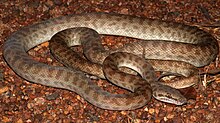| Antaresia | |
|---|---|

| |
| Children's python, A. childreni | |
| Scientific classification | |
| Domain: | Eukaryota |
| Kingdom: | Animalia |
| Phylum: | Chordata |
| Class: | Reptilia |
| Order: | Squamata |
| Suborder: | Serpentes |
| Family: | Pythonidae |
| Subfamily: | Pythoninae |
| Genus: | Antaresia Wells & Wellington, 1984 |
| Type species | |
| Antaresia childreni | |
| Species | |
|
Four species and two subspecies, see text. | |
| Synonyms | |
| |
Antaresia is a genus of pythons, nonvenomous snakes in the family Pythonidae. The genus is native to Australasia. The genus is known by the common name Children's pythons, the name of the type species, Antaresia childreni. Gray named A. childreni in honour of his mentor, John George Children, who was a curator of the zoological collection at the British Museum around that time. It contains the smallest members of the Pythonidae.[2] Four species and two subspecies are recognized, although they were all considered part of the same species until recently.[3] A newly described form called the pygmy banded python may be a distinct species, but analysis has not yet been performed on this animal. The largest recorded examples of Antaresia species have all been males, suggesting males of the known species in this genus may compete for females. This behavior has never been witnessed in the wild, and has only been witnessed in captive specimens.[4]
- ^ McDiarmid RW, Campbell JA, Touré TA (1999). Snake Species of the World: A Taxonomic and Geographic Reference, vol. 1. Washington, District of Columbia. Herpetologists' League. ISBN 1-893777-00-6 (series). ISBN 1-893777-01-4 (volume). Antaresia: pp. 162–163.
- ^ Bush, Brian; Maryan, Brad; Browne-Cooper, Robert; Robinson, David (2007). Reptiles and Frogs in the Bush: Southwestern Australia. University of Western Australia Press. p. 99. ISBN 978-1-920694-74-6.
- ^ "Antaresia". Integrated Taxonomic Information System. Retrieved 24 June 2021.
- ^ Julander, Justin; Mutton, Nick; Birch, Peter (2013). The Complete Children's Python: A Comprehensive Guide to the Natural History, Care, and Breeding of Antaresia Species. ECO Herpetological Publishing & Distribution. ISBN 978-1-938850-05-9.[page needed]